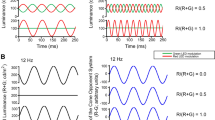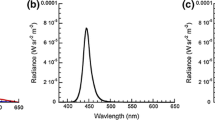Abstract
Dynamical characteristics of the electroretinogram (ERG) of a tree shrew were measured. Since this animal has a cone dominated receptor population (95%) comparison to human photopic vision is obvious. The light source was chosen to stimulate the red cones of this deuteranopic animal predominantly. Masking experiments displayed a reasonable correspondence to human foveal psychophysics. De Lange curves and CFF values revealed a maximum sensitivity at 15–20 Hz, which is higher than is found for human vision.
A secondary maximum was observed in the De Lange curves at high adaptation levels, which is possibly due to interactions of the ERG components. The dependency of integration time on adaptation level appeared to be similar to known data of human psychophysics and electrophysiological data from Limulus receptor cells.
Similar content being viewed by others
References
Boynton, R. M.: Discrimination of homogeneous double pulses of light. In: Handbook of Physiology, Vol. VII/4, pp. 202–232. (D. Jameson, L. Hurvich, eds.). Berlin-Heidelberg-New York: Springer 1972
Brown, K. T., Watanabe, K., Murakami, M.: The early and late receptor potentials of monkey cones and rods. Cold Spring Harbor Symp. Quant. Biol.30, 457–482 (1965)
Coenen, A. M. L., Eijkman, E. G. J.: Optic tract and geniculate unit responses corresponding to human visual masking effects. Exp. Brain Res.15, 441–451 (1972)
Crawford, B. H.: Visual adaptation in relation to brief conditioning stimuli. Proc. Roy. Soc. B134, 283–302 (1947)
De Lange, H.: Research into the dynamic nature of the human foveacortex systems with intermittent and modulated light. I. Attenuation characteristics with white and colored light. J. Opt. Soc. Am.48, 777–784 (1958)
Dieterich, C. E.: Die Feinstruktur der Photoreceptoren des Spitzhörnchens (Tupaia glis). Anat. Anz.125, Suppl. (1969)
Dodge, F. A., Knight, B. W., Toyoda, J.: Voltage noise in Limulus visual cells. Science160, 88–90 (1968)
Fricker, S. J.: Application of synchronous detector techniques for electroretinographic studies in patients with retinitis pigmentosa. Invest. Ophthal.10, 329–339 (1971)
Graf, V.: De Lange characteristics for the fresh-water turtle chrysomys picta picta and the pigeon Columbia livia. Vision Res.13, 1815–1822 (1973)
Grind, W. A. van de, Grüsser, O.-J., Lunkenheimer, H. U.: Temporal transfer porperties of the afferent visual system. Psychophysical, neurophysiological and theoretical investigations. In: Handbook of Sensory Physiology, Vol. VII/3a. pp. 431–573. (R. Jung, ed.). Berlin-Heidelberg-New York: Springer 1973
Hafleigh, A. S., Williams, C. A.: Antigenic correspondence of serum albumines among the Primates. Science151, 1530–1535 (1966)
Heck, J.: The flicker electroretinogram of the human eye. Acta Physiol. Scand.39, 158–166 (1957)
Kahneman, D.: Method, findings and theory in studies of visual masking. Psychol. Bull.70, 404–425 (1968)
Kelly, D. H.: Visual responses to time dependent stimuli. I. Amplitude sensitivity measurements. J. Opt. Soc. Am.51, 422–429 (1961)
Kelly, D. H.: Flicker. In: Handbook of Physiology, Vol. VII/4. pp. 273–302. (D. Jameson, L. Hurvich, eds.). Berlin-Heidelberg-New York: Springer 1972
Laak, H. J. ter: Electrophysiological investigations into luminance coding in the retina of a tree shrew (Tupaia chinensis). Thesis, University of Nijmegen (1975)
Laak, H. J. ter, Thijssen, J. M., Vendrik, A. J. H.: A method for prolonged electrophysiological experiments with a tree shrew (Tupaia chinensis). Z. Versuchstierk.17, 195–204 (1975)
Matin, L.: Critical duration, the differential luminance threshold, critical flicker frequency, and visual adaptation: a theoretical treatment. J. Opt. Soc. Am.58, 404–415 (1968)
Ordy, J. M., Samorajski, T.: Visual acuity and ERE-CFF in relation to the morphologic organization of the retina among diurnal and nocturnal primates. Vision Res.8, 1205–1225 (1968)
Padmos, P., Norren, D. V.: The vector-voltmeter as a tool to measure ERG spectral sensitivity and dark adaptation. Invest. Ophthal.11, 783–788 (1972)
Polson, M. C.: Spectral sensitivity and color vision inTupaia glis. Thesis, Indiana University (1968)
Roufs, J. A. J.: Dynamic properties of Vision I. Experimental relationships between flicker and flash thresholds. Vision Res.12, 261–278 (1972)
Schiller, P. H.: Behavioral and electrophysiological studies of visual masking. In: Information processing in the nervous system, pp. 141–166. (K. N. Leibovic, ed.). Berlin-Heidelberg-New York: Springer 1969
Schwaier, A.: Breeding tupaias (Tupaia belangeri) in captivity. Z. Versuchstierk.15, 553–563 (1973)
Thijssen, J. M., Laak, H. J. ter: Invariances of the cone-dominated ERG (tree shrew and man). In: New Developments in Ophthalmology, pp. 331–340. (A. F. Deutman, ed.). The Hague: Junk 1976
Thijssen, J. M., Dongen, P. A. M. van, Laak, H. J. ter: Maintained activity of cells in the tree shrew's optic tract. Exp. Brain Res.25, 279–290 (1976)
Tigges, J.: Untersuchungen über den Farbensinn vonTupaia glis (Diard. 1820). Z. Morph. Anthrop.53, 109–123 (1963)
Tigges, J., Brooks, B. A., Klee, M. R.: ERG recordings of a Primate pure cone retina (Tupaia glis). Vision Res.7, 553–563 (1967)
Author information
Authors and Affiliations
Rights and permissions
About this article
Cite this article
Thijssen, J.M., Laak, H.J.T. & van Well, P.M.A. Masking, De Lange curves and integration time as revealed by the electroretinogram of a tree shrew (Tupaia chinensis). Pflugers Arch. 373, 199–204 (1978). https://doi.org/10.1007/BF00584861
Received:
Issue Date:
DOI: https://doi.org/10.1007/BF00584861




